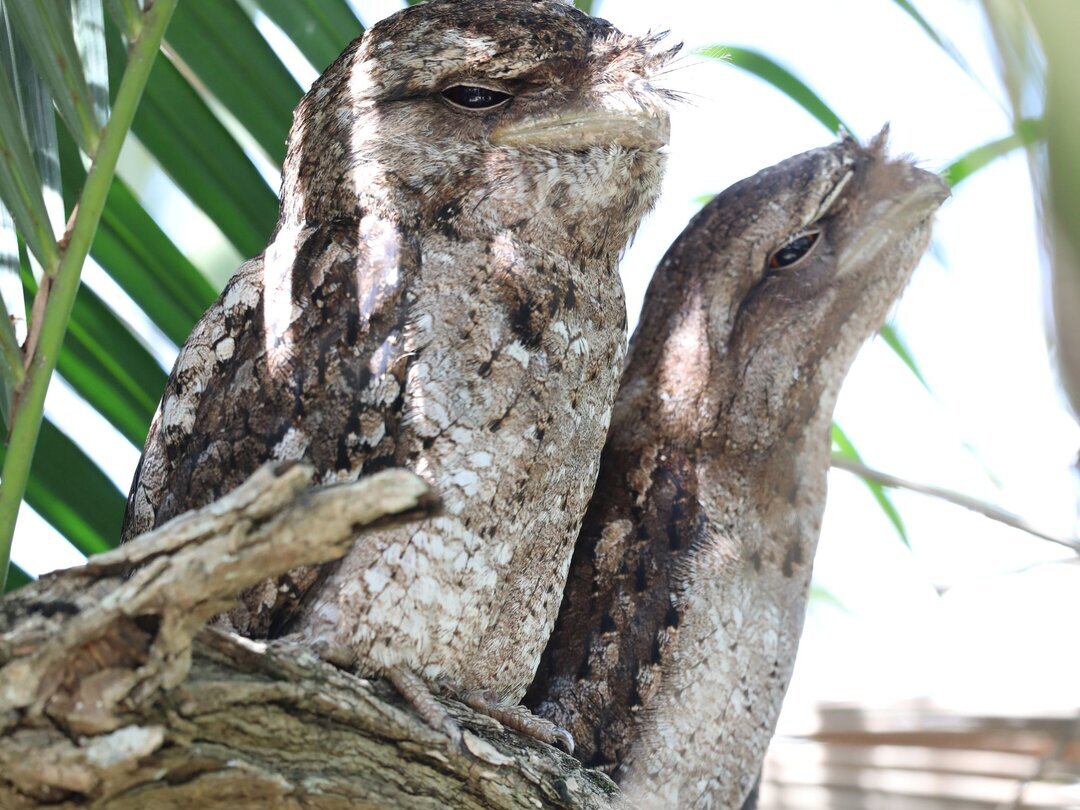Papuan Frogmouths: Port Douglas' Most Mysterious Residents

Papuan Frogmouths: Port Douglas' Most Mysterious Resident
One of the most bizarre and elusive birds in Far North Queensland isn’t rare—it’s just really, really good at hiding.
A Bird That Looks Like a Branch? Meet the Papuan Frogmouth
If you’re lucky—and looking closely—you might spot one of the Papuan Frogmouths that call The Lazy Lizard grounds home. With their uncanny camouflage and otherworldly red eyes, these birds are equal parts eerie and enchanting. Despite their reptilian stare, they’re completely harmless and actually a vital part of the local ecosystem.
Native to northern Australia and New Guinea, Papuan Frogmouths (Podargus papuensis) are often mistaken for owls but are actually more closely related to nightjars. They are nocturnal, carnivorous, and masters of disguise.
According to the Wildlife Habitat Port Douglas, “Papuan Frogmouths are often overlooked due to their incredible camouflage. During the day, they perch motionless on branches, mimicking a broken limb.”
What Makes Them So Special?
- They’re Huge
Papuan Frogmouths are the largest of all frogmouth species, growing up to 53 cm long (about the size of a small house cat). Their size alone makes them a standout, but spotting one can still feel like a magic trick—they’re right there, and yet invisible. - Those Eyes Though
Unlike their more commonly spotted cousin, the Tawny Frogmouth, which has yellow eyes, the Papuan version sports deep red eyes that glow menacingly under torchlight. It's one of the easiest ways to tell them apart. - Weird and Wonderful Feeding Habits
At night, they hunt moths, beetles, and the occasional small lizard or frog. Some researchers suggest they may even sit with their mouths open to catch insects attracted by moonlight, like a live bug zapper. As noted by Animalia.bio, they use their wide, frog-like mouths to snatch prey mid-flight.
Where to Spot One in Port Douglas
The Papuan Frogmouth’s habitat includes tropical lowland forests, woodlands, and even urban gardens. That means right here, in Port Douglas, they’re often found roosting in well-vegetated backyards or quiet treetops—like those surrounding the Lazy Lizard grounds.
Unlike birds that chirp or sing, frogmouths make low, booming calls at night, almost like a deep growl or “oom-oom” sound. If you're having a nightcap outside your unit and hear something prehistoric, don’t panic—it’s just your feathered neighbour saying hello.
Want to spot a frogmouth in the wild? Our quiet location near the rainforest gives you a front-row seat—come stay with us.
Are They Endangered?
Not at all. In fact, BirdLife Australia lists Papuan Frogmouths as a species of "Least Concern." That doesn’t mean they’re common everywhere, but it does mean their numbers are relatively stable—thanks in part to protected habitats and public awareness.
That said, their survival depends on the health of Australia’s northern woodlands, which are vulnerable to land clearing, invasive species, and climate change.
Fun Fact: They're Not Owls
Despite their nighttime activity and somewhat similar silhouette, Papuan Frogmouths aren’t owls. As Wikipedia notes, their taxonomic family is Podargidae, distinct from owls (Strigiformes). They don’t have talons or sharp beaks, and their flight is slow and quiet—built more for stealth than speed.
Key Takeaways
- The Papuan Frogmouth is the largest member of the frogmouth family and is commonly found in northern Australia, including Port Douglas.
- They’re nocturnal hunters with a diet of insects and small vertebrates.
- Incredible camouflage makes them hard to spot—they mimic tree branches by day.
- Unlike owls, they belong to a completely different family and are harmless to humans.
- You might just spot one at The Lazy Lizard, especially at dusk or dawn.
Planning your stay in Port Douglas? Ask us where the frogmouths like to roost—we’re happy to point you in the right direction (binoculars optional, curiosity required).
View our other articles
 Book Now
Book Now